Address any questions or comments regarding this newsletter to the individual authors listed after each article or to its editors, Nathan Johanning, 618-939-3434, njohann@illinois.edu or Bronwyn Aly 618-695-6060, baly@illinois.edu. The Illinois Fruit and Vegetable News is available on the web at: http://ipm.illinois.edu/ifvn/. To receive or be removed from email notification of new postings of this newsletter, contact Nathan Johanning or Bronwyn Aly at the phone numbers or email addresses above.
In This Issue:
Upcoming Programs (listings for beginning and established growers)
News and Announcements (Pumpkin Field Day, On-Farm Readiness Reviews for Illinois)
Regional Reports (east central, west central, St. Louis metro east, southern Illinois, Dixon Springs)
Fruit and Vegetable Production and Pest Management (Be Vigilant for Potential Downy Mildew in Pumpkins, Common Tomato Fruit Issues: Anthracnose ∓ Stink Bugs, Timely Harvesting of Garlic)
Upcoming Programs
Check the Illinois SARE calendar for a full list of programs and links for registration.
http://illinoissare.org/ and http://illinoissare.org/calendar.php
Also see the University of Illinois Extension Local Food Systems and Small Farms Team's website at:
http://web.extension.illinois.edu/smallfarm/ and the calendar of events at http://web.extension.illinois.edu/units/calendar.cfm?UnitID=629.
- Southern Illinois Summer Twilight Series: Blake Gerard Farms, 26845 Ditch Rd., McClure, IL, Monday, August 20, 2018 6 p.m. 6 p.m. This fourth and final twilight meeting of the summer series will be at the first rice farm in Illinois and cover production and developing local wholesale and retail marketing and branding of specialty rice. For further information contact Bronwyn Aly at baly@illinois.edu or 618-695-6060.
- Kiefner Farms Agricultural Tour, August 22, 2018, 9 AM. Kiefner Farms, 15002 W Hoff Rd., Manhattan, IL 60442 (Will County). Kiefner Farms - owned and operated by hosts John and Sherri - will provide information on their goals and how they look for new income sources and adventures in farming. They will provide their philosophy behind diversification and choice of different crops to grow, while also raising livestock (chickens and honey bees). Though they grow row crops, they also grow pumpkins for sale during Halloween time. They practice soil conservation by growing cover crops during the off-season periods. Throughout the year, quality local honey that is harvested from their apiaries is available. Get more information at See more Kiefner Farms information at https://www.facebook.com/KiefnerFarms/ .Register by calling James Theuri at 815-933-8337 or email him at jtheu50@illinois.edu . A minimum number is required to hold the event.
- 2018 Pumpkin Field Day, Thursday, September 6, 2018, 10 a.m. Ewing Demonstration Center (located about 20 minutes south of Mt. Vernon, IL) 16132 N. Ewing Rd. Ewing, IL 62836. Pumpkin Variety & Pest Management trials, No-till Production and more! This program is FREE and includes lunch but pre-registration is required at https://go.illinois.edu/pumpkinday2018 or by calling the Jackson County office at 618-687-1727, by Friday August 31, 2018. For additional information contact Nathan Johanning at 618-687-1727 or njohann@illinois.edu.
- Midwest Mechanical Weed Control Field Day Wednesday September 26, 2018 PrariErth farm in Atlanta, Illinois. Visit https://thelandconnection.org/farmers/mechanical-weed-control-field-day-2018 for more details and information about the field day as time gets closer.
News and Announcements
Pumpkin Field Day to be Held at Ewing Demonstration Center September 6
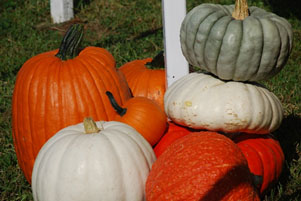
Photo: L. George
Pumpkins are a huge part of the specialty crop industry in Illinois and the Midwest. Those who want to learn more about raising pumpkins or get the latest information on new varieties and pest management practices should make sure to attend the annual Pumpkin Field Day hosted by the University of Illinois Extension.
The 2018 Pumpkin Field Day will be held Thursday, Sept. 6, at 10 a.m. in southern Illinois at the Ewing Demonstration Center located at 16132 N. Ewing Rd. in Ewing (about 20 minutes south of Mt. Vernon, IL).
Registration will open at 9 a.m., with a welcome starting at 10 a.m.
During the course of the day, U of I Extension specialists and educators will discuss a range of pumpkin production topics including: variety selection, disease and weed management, soil fertility, and overall crop management. A pumpkin variety trial with 75 different cultivars has been established, as well as field demonstration plots to accompany each of the presentations.
This year's event will also feature an ornamental miniature popcorn variety trial to complement the pumpkin trials. Laura Ingwell, an entomologist at Purdue University, will provide information on insect pest management and pollinator stewardship in pumpkins. There will also be a small trade show with vendors from the seed and crop protection industry to meet with as well.
Directions:
From I-57, take exit 77 IL 154/Sesser. Head east on IL 154 to IL 37. Turn left (north) on IL 37 for about 3/4 of a mile and turn right on Ewing Rd. Take this approximately 3 miles to Ewing and turn left on Main St. (N Ewing Rd.) in Ewing. Travel about 1/2 mile and the road to the Ewing Demonstration Center will be on the right. Look for signs.
The 2018 Pumpkin Field Day is free to the public and lunch will be provided. Registration is required by Friday, Aug. 31. Register online at https://go.illinois.edu/pumpkinday2018 or by calling 618-687-1727.
For more information contact Nathan Johanning at njohann@illlinois.edu or 618-687-1727. If you are interested in being a vendor/sponsor of the field day visit: https://web.extension.illinois.edu/registration/?RegistrationID=14879.
On-Farm Readiness Reviews (OFRR) for Illinois
The On-Farm Readiness Review (OFRR) is a voluntary assessment used to familiarize Illinois farmers with the requirements of the Food Safety Modernization Act (FSMA) Produce Safety Rule. This program provides an opportunity for farmers to discuss areas of their operation and will assist growers recognize areas for improvement. The program in Illinois is being offered, free of charge, to any farmer that has completed or plans to attend a Produce Safety Alliance Grower Training workshop (or equivalent) https://producesafetyalliance.cornell.edu/training/grower-training-courses/
The Produce Safety Rule became effective on January 26, 2016. The initial compliance dates are: January 26, 2018 for large farms; January 28, 2019 for small farms; and January 27, 2020 for very small farms. FDA farm inspections will begin with the large farms in Spring 2019. In Illinois, the Food and Drug Administration will be responsible for farm inspections under the FSMA Produce Safety Rule. To understand what this means, you need to become familiar with the differences between a third-party audit and a FDA inspection:
Third-Party Market Access Audit:
- Third party market access audits are generally audits conducted to assess whether or not a producer meets the food safety requirements of a specific buyer(s). These requirements can be above and beyond what is required by the FSMA Produce Safety Rule.
- Many audits are points based, meaning the farm either passes/fails depending on the number of points received during the farm inspection by the third-party auditor; some audits are based on a farm-specific risk assessment
- Audits are voluntary, upon request of the farmer and are usually done annually
- The audit "scope" is determined by the farmer and can be limited to specific crops or specific parts of the operation
- The consequences of failure to pass an audit are potential loss of sales/markets
FDA Inspections:
- Are mandated by Federal Regulation
- Are not point-based
- Inspections are intermittent
- An inspection covers the whole farm, not just specific crop(s)
- Non-compliance with the Produce Safety Rule may be followed by enforcement actions.
While some farms may be familiar with the Produce Safety Rule and how it impacts their farm, others may be less familiar. The On-Farm Readiness Review provides an opportunity for farmers, at any level of preparedness, to get individual feedback on their readiness for compliance with the Produce Safety Rule before they receive their first inspection. This tool is consistent with FDA's "Educate Before and While We Regulate" approach. On-farm reviews will cover farm practices that may include growing, harvesting, and postharvest activities on the farm. FDA farm inspections will begin in 2019.
Farmers who have interest in having an OFRR of their farm should contact the Food and Drug Administration at RequestAnOFRR@fda.hhs.gov or by mail:
U.S. Food and Drug Administration
c/o Produce Safety Network
Center for Food Safety and Applied Nutrition
Fresh Produce Safety Branch (HFS 317)
5001 Campus Drive
College Park, MD 20740
Or by contacting Laurie George at ljgeorge@illinois.edu or calling (618) 242-0780.
Additional information concerning the Produce Safety Rule and OFRR can be found at:
https://www.ncrfsma.org/
https://www.farmcrediteast.com/knowledge-exchange/Blog/todays-harvest/fsma-update---wall
Regional Reports
From east central Illinois...Fungal diseases are noticeable in fields where fungicide applications have not been done in a timely manner. Farmers are busy with harvesting summer crops and beginning planting of fall crops.
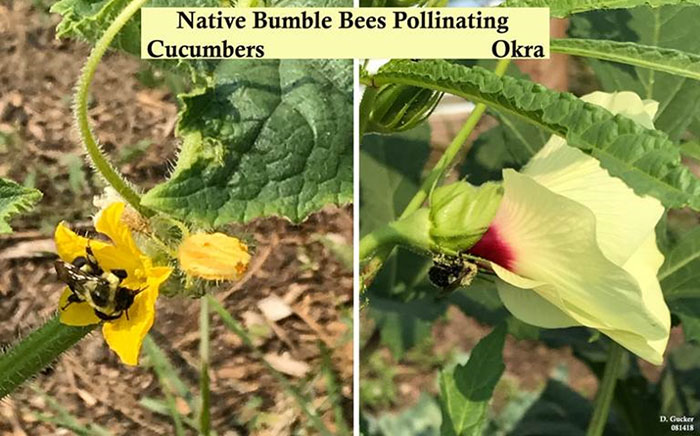
In a local urban CSA field, I noticed that the okra and cucumber plants were being pollinated by native bumble bees. We sometimes forget that our local native bees are more efficient pollinators than the honeybee (Apis mellifera) brought over from Europe. (Source- R. Winfree, J. Dushoff, C. Kremen; "Native bees provide insurance against ongoing honey bee losses". Ecology Letters, vol. 10, issue 11.)
Doug Gucker (217-877-6042; dgucker@illinois.edu)
From west central Illinois...It has been dry. Our lawns have gone dormant awaiting the return of rainfall. The heirlooms I grow in my backyard languish, as I have not kept on top of their watering. Yet, our irrigated beds show no drought stress, and many of the watered crops continue to thrive despite the rain shortage. According to the extended forecast, it seems we are about to enter a pattern of needed rainfall. Probably by the next regional report, I will be admonishing the deluge in the garden.
We are beginning our transition to cool season crops. I always look forward to fall crops with anticipation. During our planning for fall, we decided to survey the consumers of our harvest. The survey asked what fall vegetables they would most likely select. The winner was cauliflower, followed by broccoli and then carrots. I was really hoping everyone would want to eat kale and Swiss chard, two very easy crops. Unfortunately, those were at the bottom of the list. If you are curious, following are the results ranked first to last place:
- Cauliflower (The winner and of course the most finicky and my least favorite plant to grow)
- Broccoli
- Carrots
- Lettuces
- Cabbage
- Radish
- Peas
- Brussels sprouts
- Beets
- Spinach
- Collards
- Kale
- Pac Choi/Kohlrabi (tied)
- Arugula
- Swiss chard (Received no votes, I demand a recount!)
We will continue with our surveys over the next couple of growing seasons (both cool and warm season vegetables). If you think I left out an important crop, please feel free to email me and we can add it to the list.
Cascade hops will be picked in the coming week. The pole beans have been incredibly bountiful with the decrease in daytime high temperatures. We picked ten pounds off just two 2x8 beds (32 square feet) last week. Scouting the garden today, I think we may beat that. Typically, we only get maybe 4 pounds from those two beds. Watermelons, being an exercise in patience, are finally ready and harvest began two weeks ago.
As far as pests, I sprayed Bt to control cabbage worms on the cole crops. Squash bugs are a constant battle. I do take a cheap thrill of finding squash bug egg masses on the underside of leaves and squishing them. I suspect downy mildew in our cucumbers. If you want to move beyond suspicion or guessing on plant disease, I highly recommend submitting samples to our University of Illinois Plant Clinic. Check out their website HERE.
Chris Enroth (309-837-3939; cenroth@illinois.edu)
From St. Louis Metro East... Sweet corn planting wound down last week, as well as green beans, okra, tomato and Jalapeno. Corn ear worm trap counts hit a peak 1-day catch of 200 on Aug 11th in the Collinsville area, followed by 150 caught on 12th, then 100-120 caught on the 13th. Counts are back to normal at 20-30 moths per day. Squash planting is winding down with maybe one more planting of butternut, spaghetti, acorn and yellow squash. Plantings still going in of Swiss chard, cabbage and spinach. Harvest is ongoing for most vegetables.
For peaches, harvest is finishing up for Bounty, Loring, Carolina Belle and Coralstar. Just starting on Cresthaven. This is also the crossover time to apples. Gala color picking is just starting and should move into full harvest within the next 2 weeks for most growers. Honeycrisp should be coming into ripeness within a week or two after Gala. Strawberry plasticulture prep has started.
A few areas within the region are in need of rain. Looking at the drought monitor, much of northern Missouri is in extreme to severe drought and in a few places drought conditions are creeping east into sections of southern Calhoun and western Madison County. The main concern is sizing on fruit, or in this case undersized fruit. Day temperatures are running around normal but the humidity remains high. Night temperatures have started to drop which is desirable for red development in apples and female flower set on cucurbits.
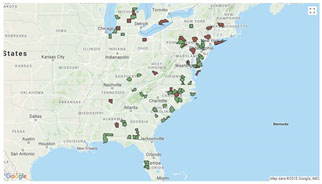
2018 Reported Outbreaks of Cucurbit Downy
Mildew as of Aug 14, 2018.
Image generated: http://cdm.ipmpipe.org
So far so good. No confirmed reports of downy mildew yet in the Illinois pumpkin crop. If you do suspect downy mildew, please let us know so we can verify and get the word out. The organism overwinters on infected cucurbits, either wild or propagated, in areas that do not experience a hard frost, such as southern Florida in the eastern United States. This means it does not overwinter in Illinois and has to travel here anew each year via sporangia (spore forming structures) on weather fronts. North Carolina State University has developed a Cucurbit Downy Mildew Forecast to assist growers in tracking the movement of downy mildew in cucurbits and is available at http://cdm.ipmpipe.org/. In addition to viewing maps showing all reported outbreaks of downy mildew, you can sign up for alerts of any new outbreaks. I have it set up to notify me of any outbreaks within 200 miles of my office location.
Elizabeth Wahle (618-344-4230; wahle@illinois.edu)
From southern Illinois... We have been in a pattern of fairly "average" summer temperatures with highs in the 80s to low 90s the last few weeks. We have had multiple storm systems come through with most areas getting rain over the past week. Here at the office on Wednesday morning (8/15) we received 0.8" and are in an unsettled weather pattern the rest of the week with varying rain chances and a fair amount of clouds. Some areas have received multiple inches of rain over the past week to 10 days depending on your location to how the rains passed through.
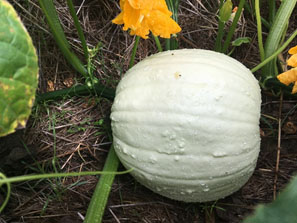
Spector, a new, white, warted pumpkin
and one of the 75 varieties in the
pumpkin trial for Pumpkin Field Day.
Photo: N. Johanning
Out in the field rains have kept crops growing, but has progressed many common diseases as well. Peach harvest continues on later varieties and apples will be just around the corner.
We are approaching peak harvest on our tomato variety trial at the office and thank you to all that came out to our Tomato Twilight Meeting on Monday. We had a great chance to share all of the varieties and discuss some management issues for growers. We will continue data collection and look forward to sharing the results at the end of the season. Our pumpkin trials at Ewing are looking great for Pumpkin Field Day. We have a pretty good set of early fruit that should ripen up by the time field day comes in 3 weeks. Vine and fruit growth has been very good and so far we have no signs of powdery mildew yet and just made another protective fungicide spray along with insecticide with cucumber beetles and a few squash bugs present. This is the first insecticide application we have made. We hope to see many of you at Pumpkin Field Day!
Nathan Johanning (618-939-3434; njohann@illinois.edu)
From Dixon Springs Ag Center...Cucumber harvest for the hydroponic variety trial has come to an end (finally, lol), with some of our vines having reached a length of 25 feet. Data will be sent to the researcher at Purdue to be included in their SARE project. We are maintaining about half of the cucumber plants from the trial with plans to play around with various fertilizer EC (electrical conductivity) rates to note any possible yield changes. Army worms have invaded our high tunnels with a vengence and received a Bt treatment for control. Spider mites have been observed again but it also appears that there are predatory mites as well, so we will continue to monitor the spider mites and hopefully not have to make a pesticide application for control. Just as an observation, Beleaf seems to have provided good aphid control on the cucumbers, peppers, and strawberries that had heavy infestations. Getting set up to put green beans in the hydroponic tunnel as well as getting the lettuce table back into production. Beets, carrots, peas, green beans, and radishes have been sowed in the ground beds. Still harvesting tomatoes, peppers, and cut flowers. The day neutral strawberries in the hydroponic stacks have started setting fruit again after about 6 weeks with no flower sets (although the runners seem to be quite prolific). Within the hydroponic tunnel, we have several different growing systems set up (dutch buckets, rail system, vertical stacks, lettuce table, basic gutter, etc) along with different crops in these systems. Peppers were planted in a basic white plastic gutter, layed directly on the ground with emitters placed at each plant. Perlite was used as the growing media and the peppers are being pruned and trained up a single trellis string suspended from the trusses (like the tomatoes and cucumbers). Peppers are just about ready to start harvesting in the next week are so.
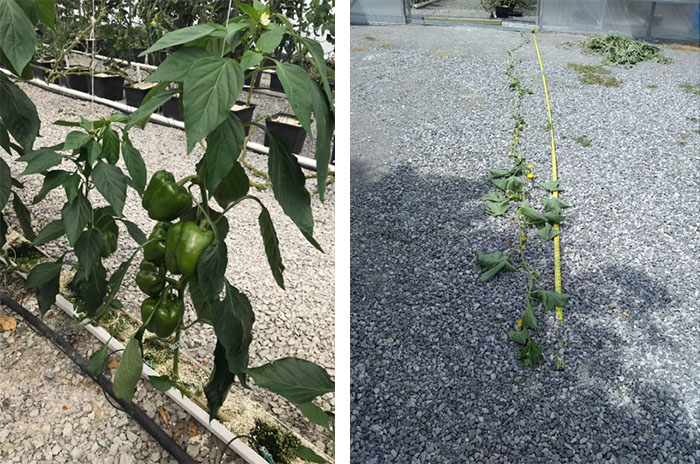
L to R: Milena bell pepper in basic hydroponic system at DSAC. Very minimal amount of perlite and plants pruned and trained to a single string suspended from truss. Hydroponic cucumber vine that had grown to 25 feet in length in just over 15 weeks.
Bronwyn Aly (618-382-2662; baly@illinois.edu)
Fruit and Vegetable Production and Pest Management
Be Vigilant for Potential Downy Mildew in Pumpkins
We have not confirmed any fields with downy mildew yet in Illinois, however, this is the time of year when the disease can hit. Some neighboring states have confirmed it and refer to the notes and map in Elizabeth Wahle's regional report for more details. It is favored by cool, wet conditions and many areas have seen unsettled weather patterns with multiple rain events so conditions are in place should the disease inoculum blow in. For more information on this pathogen, refer to Dr. Babadoost's Report on Plant Disease on Downy Mildew which can be found at this site http://extension.cropsciences.illinois.edu/fruitveg/pdfs/925_downy_mildew.pdf
If you suspect that you have downy mildew on pumpkins, please contact our pathologist Dr. Babadoost at babadoos@illinois.edu or 217-333-1523. Email including close up pictures of the leaf symptoms is the best way to contact him.
Nathan Johanning (618-939-3434; njohann@illinois.edu)
Common Tomato Fruit Issues: Anthracnose & Stink Bugs
I just wanted highlight a few common tomato fruit issues we have observed this season.
Anthracnose is a fungal disease that especially impacts tomato fruit. It is observed on fruit as small, sunken, watersoaked spots that quickly grow in size over the fruit. The infections can happen to green or ripe fruit, but do not show up on fruit until they ripen. Once ripe lesions grower rapidly and often may not be noticed at harvest but will become more noticeable postharvest and lead to complete rotting of the fruit.
Anthracnose can infect fruit from plant debris/soil splash so lower fruit and those more exposed to the soil are more prone to infection. Rainy weather with high moisture also favors this pathogen spread. Mulches and trellising tomatoes can be helpful to prevent the infection from occurring. Preventative fungicide applications once fruit are formed greatly reduce the incidence of this disease. We had some of this occur in our variety trial and included Quadris in rotation with Bravo Weatherstik in our rotation and have greatly improved fruit quality. For additional recommendations refer to the Midwest Vegetable Production Guide.
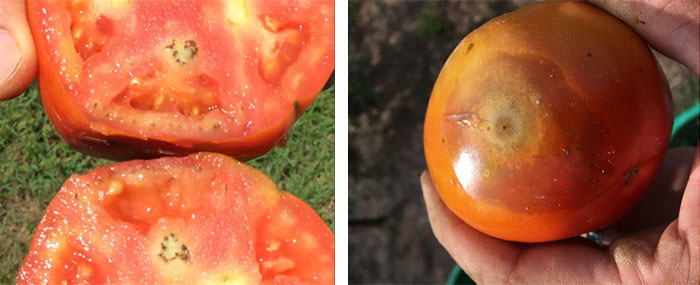
Anthracnose infection on tomato fruit. Brown fungal growth inside tomato fruit as lesion progresses (left). Fruit lesion on fruit surface (right). Photos: N. Johanning
Stink Bug damage is often another problem we see especially later in the season. These yellow, corky spots on the fruit surface and extending down into the fruit are from the tomato healing around stink bug feeding. This does affect the fruit quality and if in high numbers beetle feeding can become very prevalent on fruit. When scouting for stink bugs,they often fall to the ground when the plant is disturbed but can be found by taking a tray or pan and holding it under the plants and disturbing the foliage hoping to catch them when they fall to the ground. Periodic scouting and insecticide applications are the best options. Many of our pyrethroid insecticide are effective, however, do scout and only spray when needed as over application can remove the natural enemies of aphids and mites and cause those pest to be problematic. For additional recommendations refer to the Midwest Vegetable Production Guide.
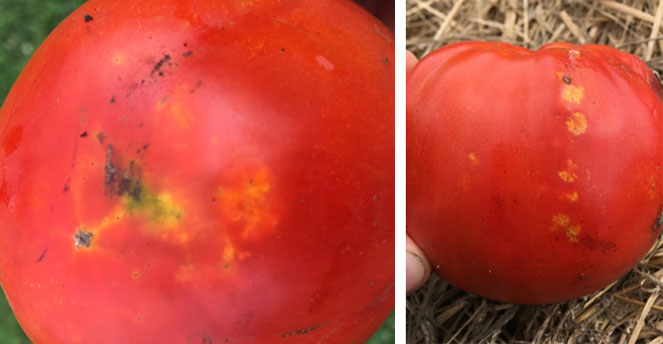
Yellow spots from stink bug feeding on tomatoes. Photos: N. Johanning
Nathan Johanning (618-939-3434; njohann@illinois.edu)
Timely Harvesting of Garlic
Timing is everything, and that saying is particularly true for garlic harvest. The crop is hidden underground, so monitor the leaves. If leaves are allowed to brown up, there is a risk of the bulbs over-ripening, the cloves will start to separate, and the uncompact heads will not store as long. Less shelf life can also result if the bulbs are harvested too early. Rule of thumb: harvest when about 5 lower leaves turn brown, and five are still green.
During harvesting, garlic should not be pulled out of the ground; use a fork to lift them. The bulbs cure and store best when the leaves covering the bulbs are left intact. Harvesting by pulling the garlic plants could peel the leaves off the bulb. In northern US, more of the hardneck garlic varieties are grown; once the scape (flower stalk-to-be) in June, it signals that the garlic will be mature in approximately one month.
What I noted when garlic (Music variety) was harvested a little too late:
- Some bulbs turned from white to brown
- Some ground-dwelling critters started to snack on the bulbs
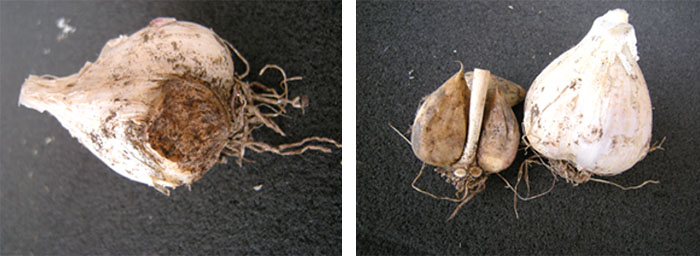
Damage to garlic harvested too late. Photos by J. Theuri.
James Theuri (815-933-8337; jtheu50@illinois.edu)
Less Seriously...
Jokes from seven year olds are never dull. At least this one didn't involve boogers.
Why can't you hear a pterodactyl use the bathroom? - Because their p is silent.
Since this is palindrome week 8-12-18, 8-13-18, 8-14-18, 8-15-18, 8-16-18, 8-17-18, 8-18-18, and 8-19-18, thought we might include a few more examples. This seems fitting as I bet most of you aren't sure if you are coming or going this time of year.
https://www.grammarly.com/blog/16-surprisingly-funny-palindromes/
A great bargain:
A nut for a jar of tuna.
A permissive friend:
Al lets Della call Ed "Stella."
An Italian palindrome:
Amore, Roma.
A moral dilemma:
Borrow or rob?
Follow the words, not the letters:
King, are you glad you are king?
A weird concept:
Taco cat
Bad eyesight:
Was it a car or a cat I saw?
A record, set straight:
Madam, in Eden, I'm Adam.
A hitman for hire:
Murder for a jar of red rum.
Call your mother:
Mom.
A gross creature:
Oozy rat in a sanitary zoo.
Verbal abuse:
Yo, banana boy!
Would you try:
UFO tofu?
University of Illinois Extension Specialists in Fruit and Vegetable Production & Pest Management
Extension Educators – Local Food Systems and Small Farms |
||
Bronwyn Aly, Gallatin, Hamilton, Hardin, Pope, Saline, and White counties |
618-382-2662 |
|
Katie Bell, Franklin, Jackson, Perry, Randolph, & Williamson counties |
618-687-1727 |
|
Sarah Farley, Lake & McHenry counties |
847-223-8627 |
|
Nick Frillman, Woodford, Livingston, & McLean counties |
309-663-8306 |
|
Laurie George, Bond, Clinton, Jefferson, Marion, & Washington counties |
618-548-1446 |
|
Zachary Grant, Cook County | 708-679-6889 | |
Doug Gucker, DeWitt, Macon, and Piatt counties |
217-877-6042 |
|
Erin Harper, Champaign, Ford, Iroquois, and Vermillion counties |
217-333-7672 |
|
Grace Margherio, Jackie Joyner-Kersee Center, St. Clair County |
217-244-3547 |
|
Grant McCarty, Jo Daviess, Stephenson, and Winnebago counties |
815-235-4125 |
|
Katie Parker, Adams, Brown, Hancock, Pike and Schuyler counties |
217-223-8380 |
|
Kathryn Pereira, Cook County |
773-233-2900 |
|
James Theuri, Grundy, Kankakee, and Will counties |
815-933-8337 |
|
Extension Educators – Horticulture |
||
Chris Enroth, Henderson, Knox, McDonough, and Warren counties |
309-837-3939 |
|
Richard Hentschel, DuPage, Kane, and Kendall counties |
630-584-6166 |
|
Andrew Holsinger, Christian, Jersey, Macoupin, & Montgomery counties |
217-532-3941 |
|
Extension Educators - Commercial Agriculture |
||
Elizabeth Wahle, Fruit & Vegetable Production |
618-344-4230 |
|
Nathan Johanning, Madison, Monroe & St. Clair counties |
618-939-3434 |
|
Campus-based Extension Specialists |
||
Kacie Athey, Entomology |
217-244-9916 |
|
Mohammad Babadoost, Plant Pathology |
217-333-1523 |
|